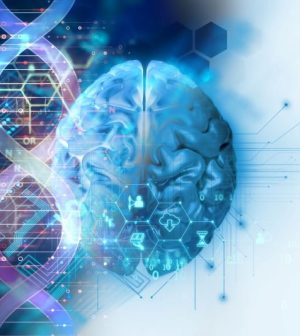- Navigating Your Midlife Crisis: Embracing New Possibilities
- City Raccoons Showing Signs of Domestication
- Mapping the Exposome: Science Broadens Focus to Environmental Disease Triggers
- One Week Less on Social Media Linked to Better Mental Health
- Your Brain Changes in Stages as You Age, Study Finds
- Some Suicide Victims Show No Typical Warning Signs, Study Finds
- ByHeart Formula Faces Lawsuits After Babies Sickened With Botulism
- Switch to Vegan Diet Could Cut Your Greenhouse Gas Emissions in Half
- Regular Bedtime Does Wonders for Blood Pressure
- Dining Alone Could Mean Worse Nutrition for Seniors
Scientists Discover Cause of Rare Movement Disorder

Researchers have conclusively identified the genetic cause of a rare, progressive movement disorder.
A rare extra-long version of a gene appears to cause nerve cells to become poisoned by toxic proteins in people with spinocerebellar ataxia 4 (SCA4), researchers report.
SCA4 causes muscle weakness and difficulty coordinating body movement, most notably resulting in a jerky and unsteady walking style and difficulty speaking, according to the National Institutes of Health (NIH).
The disease also causes a progressive loss of feeling in the hands and feet and a loss of reflexes, the NIH says.
There’s no known cure for SCA4, and up to now there was no known cause, researchers said.
SCA4’s pattern of inheritance had long made it clear the disease was genetic, but researchers have struggled for 25 years to figure out the exact genetics behind the disorder.
Now, using a recently developed advanced sequencing technology to analyze the genetics of several Utah families, researchers found a section in a gene called ZFHX3 that’s much longer than it should be, containing an extra-long string of repetitive DNA.
Human cells that have the extra-long version of ZFHX3 appear to be sick. They aren’t able to recycle proteins as well as they should, and some contain clumps of stuck-together protein.
“This mutation is a toxic expanded repeat and we think that it actually jams up how a cell deals with unfolded or misfolded proteins,” said senior researcher Dr. Stefan Pulst, chair of neurology at the University of Utah School of Medicine.
Healthy cells need to constantly break down proteins that are no longer functioning. Researchers demonstrated that the SCA4-causing mutation could essentially poison nerve cells by gumming up the works of the cells’ protein-recycling machinery.
The new study was published April 29 in the journal Nature Genetics.
Figuring out the cause of SCA4 is the first step in developing effective treatments, Pulst said.
“The only step to really improve the life of patients with inherited disease is to find out what the primary cause is,” Pulst said in a university news release. “We now can attack the effects of this mutation potentially at multiple levels.”
For example, a similar process interfering with protein recycling occurs in another movement disorder called SCA2, researchers noted.
A potential therapy for SCA2 is currently being tested in a clinical trial, and there’s a possibility that it might work for SCA4 as well, given the results of this study.
People in families affected by SCA4 can also find out if they have this specific genetic change, which can help them prepare for its onset, said lead researcher Pattie Figueroa, a project manager in neurology at the University of Utah School of Medicine.
“They can come and get tested and they can have an answer, for better or for worse,” Figueroa said.
“I’ve been working on SCA4 directly since 2010 when the first family approached me, and once you go to their homes and get to know them, they’re no longer the number on the DNA vial,” Figueroa added. “These are people you see every day… You can’t walk away. This is not just science. This is somebody’s life.”
More information
The National Institutes of Health has more about SCA4.
SOURCE: University of Utah, news release, April 29, 2025
Source: HealthDay
Copyright © 2025 HealthDay. All rights reserved.










